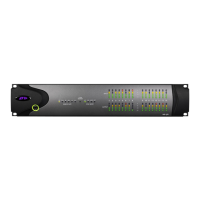Pro Tools | HD I/O Guide10
AES/EBU [Encl]
These are balanced, three-conductor XLR connec-
tors that accept and output a stereo, 24-bit
AES/EBU audio signal. These two ports support
up to 192 kHz sample rates.
Optical (ADAT) [Encl]
These Optical ports provide up to eight channels of
Optical (ADAT) input and output, or two channels
(stereo) optical S/PDIF input and output. Optical
(ADAT) mode supports sample rates up to 48 kHz.
Using S/MUX, these Optical ports support provide
up to four channels of Optical S/MUX input and
output at sample rates of 88.2 and 96 kHz, and up
to two channels of Optical S/MUX input and out-
put at sample rates of 176.4 and 192 kHz. In TOS-
Link mode, the ports support two channels of Op-
tical input and output at sample rates up to 96 kHz.
About Lightpipe-Compatible Devices
Lightpipe is an industry standard, eight-channel
optical digital audio connection created by Alesis.
Lightpipe is found on many devices, including Op-
tical (ADAT) decks, modular digital multitracks
(MDMs), A/D or D/A converters, S/MUX, and
digital consoles.
S/PDIF Digital In and Out
These are unbalanced RCA jacks that receive and
send two channels of S/PDIF audio. S/PDIF sup-
ports up to 24-bit audio, at sample rates up to 192
kHz.
DigiLink Mini Ports
PRIMARY PORT
Use the PRIMARY PORT to connect HD I/O to
HDX or HD Native cards using a DigiLink Mini
cable, or to Pro Tools|HD cards using a DigiLink
cable with a DigiLink Mini adapter.
The Primary port sends and receives 32 channels to
and from an HDX, HD Native, or Pro Tools|HD
card. Input and output channels 17–32 (if active)
are passed through to the EXPANSION PORT.
EXPANSION PORT
The EXPANSION PORT lets you connect an ad-
ditional Avid HD audio interface to HD I/O. The
EXPANSION PORT passes input and output
channels 17–32 to the expansion (or secondary)
audio interface.
This port is only available when HD I/O is con-
nected directly to an HDX, HD Native, or
Pro Tools|HD card. It is not available when the
HD I/O is connected to the Expansion Port on an-
other audio interface.
Configure HD I/O for ADAT S/MUX on the
enclosed ADAT port and also on the ADAT
port on the Digital I/O card to get 8 channels
at 88.2/96 kHz or 4 channels at
176.4/192 kHz.
To maintain data integrity and minimize jit-
ter, use only 75-ohm coaxial cable for
S/PDIF connections.

